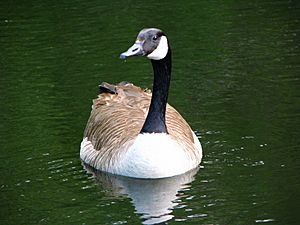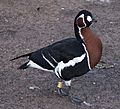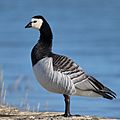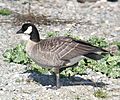Branta facts for kids
The black geese are a group of birds called waterfowl. They belong to the goose and swan family, and their scientific name is Branta. You can find them in northern coastal areas of Europe and Asia, and all across North America. Many black geese migrate to warmer southern coasts in winter. Some even live all year round in the Hawaiian Islands. Interestingly, a group of Canada geese that were brought to New Zealand now live there on their own.
They are called 'black geese' because they all have a lot of black feathers. You can tell them apart from other geese because their legs and feet are black or very dark grey. They also have black beaks and large black areas on their heads and necks. Most species have white (or sometimes yellowish) markings that help you tell them apart. Like most geese, the feathers under and over their tails are white. Black geese are usually smaller than other geese, but some types can be quite large!
The black geese found in Europe and Asia usually live near the coast. They don't often go far inland, even in winter. This is different from the 'grey geese' (another group of geese) that share the same areas. However, this isn't true for the black geese in America and the Pacific, as grey geese are mostly absent there.
Quick facts for kids BrantaTemporal range:
Late Miocene-Holocene |
|
|---|---|
 |
|
| A Canada goose (Branta canadensis) swimming at Smythe Park, Toronto, Ontario, Canada | |
| Scientific classification |
|
| Kingdom: | Animalia |
| Phylum: | Chordata |
| Class: | Aves |
| Order: | Anseriformes |
| Family: | Anatidae |
| Subfamily: | Anserinae |
| Genus: | Branta Scopoli, 1769 |
| Type species | |
| Anas bernicla (Brant goose) Linnaeus, 1758
|
|
| Species | |
|
Branta bernicla |
|
| Synonyms | |
|
Nesochen Salvadori, 1895 |
|
What's in a Name?
The scientific name Branta was first used by an Austrian scientist named Giovanni Antonio Scopoli in 1769. The name comes from an old Norse word, Brandgás, which means "burnt (black) goose". The most well-known species in this group is the Brant goose (Branta bernicla).
Scientists have studied how these geese are related to each other. In 2016, a study showed the family tree of the Branta species:
| Branta |
|
|||||||||||||||||||||||||||||||||
Types of Black Geese
There are six living species of black geese. Here's a list of them:
| Image | Scientific name | Common name | Where they live |
|---|---|---|---|
 |
Branta bernicla | Brant (U.S.) or brent goose (U.K.) | Found in the Arctic tundra around the world. They breed in the far north and spend winters along the northern coasts of the Atlantic and Pacific. Some groups live in the United States and Western Europe all year. |
 |
Branta ruficollis | Red-breasted goose | Lives in Arctic Siberia, especially on the Taymyr Peninsula. Smaller groups are found in other parts of Siberia and they winter on the northwestern shores of the Black Sea (Bulgaria, Romania, Ukraine). |
 |
Branta sandvicensis | Nene, nēnē, or Hawaiian goose | Lives only in the Hawaiian Islands. |
 |
Branta canadensis | Canada goose | Common in temperate parts of North America. They have also been introduced to Western Europe, Scandinavia, Japan, New Zealand, Chile, Argentina, and the Falkland Islands. |
 |
Branta leucopsis | Barnacle goose | Found on Arctic islands in the northeastern Atlantic. |
 |
Branta hutchinsii – used to be part of B. canadensis | Cackling goose | Lives in North America, northern Canada, and Alaska. |
Ancient Black Geese
Scientists have found bones of two extinct species of black geese in the Hawaiian Islands. These birds died out long ago, before humans arrived:
- †Nēnē-nui or wood-walking goose, Branta hylobadistes
- †Giant Hawaii goose, Branta rhuax
The Giant Hawaii goose was once thought to be a different type of bird. But after looking at its bones again in 2013, scientists realized it was actually a very large Branta goose.
Fossil Discoveries
Many fossil species of Branta have been found. It can be tricky to tell them apart from other geese just by their bones. Some fossil geese found in North America were once thought to be 'grey geese', but it's not always clear if they truly belong to that group or to Branta.
Here are some fossil species that have been described:
- Branta woolfendeni (found in USA)
- Branta thessaliensis (found in Greece)
- Branta dickeyi (found in Western USA)
- Branta esmeralda (found in USA)
- Branta howardae (found in USA)
- Branta propinqua (found in USA)
- Branta hypsibata (found in USA)
One fossil, "Branta" minuscula, is now believed to be an ancient American shelduck.
See also
 In Spanish: Barnacla para niños
In Spanish: Barnacla para niños

